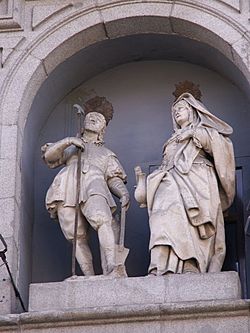Maria Torribia facts for kids
Quick facts for kids BlessedMaria Toribia |
|
|---|---|

Statues of St. Isidore and Bl. Maria Torribia (María de la Cabeza) on the facade of the Colegiata de San Isidro in Madrid.
|
|
| Born | Unknown Caraquiz |
| Died | 1175 Torelaguna |
| Venerated in | Catholic Church |
| Beatified | 11 August 1697, Saint Peter's Basilica, Papal States by Pope Innocent XII |
| Feast |
|
| Patronage | World Youth Day 2011 |
Maria Toribia (died 1175) was a Spanish woman who is believed to have married Saint Isidore. She is also known in Spain as Santa María de la Cabeza, which means Saint Mary of the Head. She is remembered for her kindness and for the miracles linked to her life.
Contents
Maria Toribia's Early Life
Maria Toribia was born around the late 1000s or early 1100s. She likely came from Caraquiz, a small village in Spain. Later, she lived in Torrelaguna, which is now part of the Madrid area.
There, she met and married Isidore, a simple farmer from Madrid. Together, they had one son named Illan.
A Miraculous Rescue
One famous story tells of a time when their son, Illan, fell into a deep well. Maria and Isidore were very worried. They prayed for help.
Suddenly, the water in the well began to rise. It rose all the way to the ground level. Their baby floated up and was easily rescued, completely unharmed! Sadly, their son later died when he was still very young.
The Never-Ending Stew
Another story shows Maria's kind heart. She always kept a pot of stew ready on the fireplace. She knew her husband Isidore often brought hungry people home.
One day, Isidore brought home more hungry people than usual. After serving many of them, Maria told him there was no more stew left. Isidore asked her to check the pot again. To her surprise, she found enough stew to feed everyone who was still hungry!
After Isidore died in 1130, Maria lived a quiet life. She was known for her deep faith and for having special visions. People believed she could perform miracles. For example, it is said she dreamed of the Virgin Mary every night. In her dream, the Virgin Mary would cross the Jarama River, spreading her cloak over the water.
Honoring Maria Toribia
After her death, Maria became known as "of the Head." This is because a special container holds her head as a relic. This relic has often been carried in parades. People believe it has brought rain to dry areas.
Her relics were moved several times. In 1769, they were placed in the Real Colegiata de San Isidro in Madrid. They are kept there with the body of her husband, Saint Isidore.
Maria Toribia was officially recognized as "Blessed" by Pope Innocent XII. This happened on August 11, 1697.
Farmers around the world honor Saint Mary of the Head. She shares a special day with her husband, Saint Isidore, on May 15. She also has her own feast day on September 9.
Maria Toribia's Lasting Example
Even though many centuries have passed, Isidore and Maria are still great examples. They show that marriage can be a path to holiness. It's not just about love or starting a family. It's also about growing in faith together.
Their example shows deep love for God and for the Blessed Virgin Mary. Since the 1200s, a group called la Real Congregación de San Isidro has shared their story. They promote the idea of a holy marriage, just like Isidore and Maria had.
In 2011, three churches in New York combined to form a new parish. They named it Ss. Isidore and Maria Torribia Parish. This name was chosen because Isidore and Maria are the patron saints of farmers. This area is mostly rural, meaning it has many farms.
The pastor, Father Patrick Connor, explained the name's meaning. He said that we all benefit from farmers' hard work. They provide us with food. So, Isidore and Maria remind us to be thankful for those who grow our food.
Images for kids
See also
 In Spanish: María de la Cabeza para niños
In Spanish: María de la Cabeza para niños



